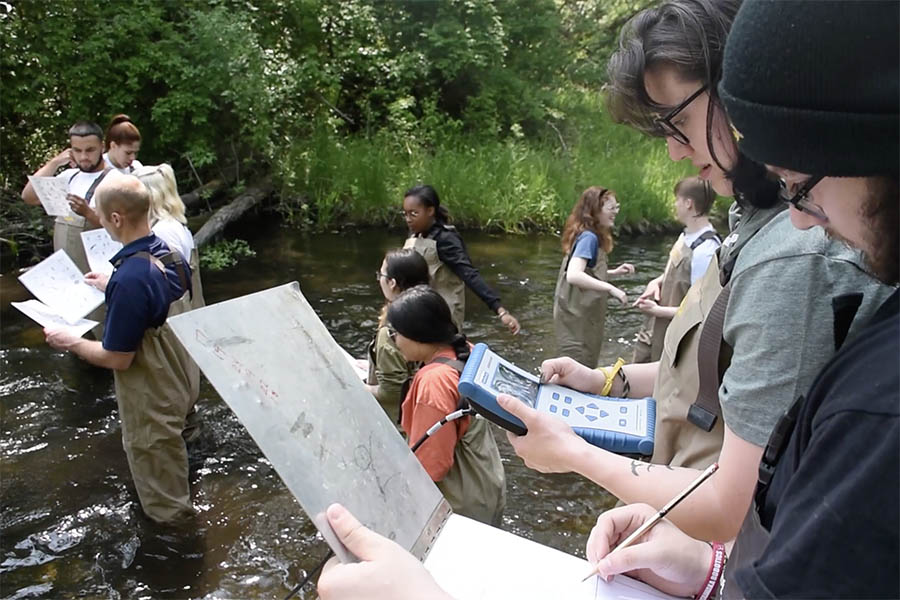Engaging in water quality investigations provides an opportunity for hands-on learning and can foster environmental stewardship. Use the tabs below to explore resources that can help you get the most out of your time with the water quality monitoring equipment.
The following steps can help you implement Limno Loan materials to bring the topic of water quality to life.
Use How’s My Waterway?, created by the U.S. Environmental Protection Agency (EPA), to find a local body of water to study. This interactive website can also help you explore and visualize water quality data and determine the health of local waterbodies.
Are you ready to dive into water quality investigations? The following resources can support lesson planning, data collection, and learner engagement.
Select a grade level to find example lessons and activities created by Limno Loan educators. We welcome your submission of lesson plans that you developed for the Limno Loan program!
Choose a data collection method. The following examples of water-quality datasheets are from fellow Limno Loan educators and can be revised to fit your needs.
Microsoft Word:
Google Docs:
These ready-to-use digital games can help increase familiarity with water quality vocabulary.
Review limnology vocabulary with this interactive crossword that is aimed at 8th-12th grade learners.
Designed for 9th-12th grade learners, this quiz explores the physical and chemical and some of the biological variables that are used to understand water quality.
This word search was created for 4th-6th grade learners to introduce the seven water quality parameters measured by a Hydrolab.
Support learning and understanding of water quality parameters with the following tools.
Water Quality Parameters Primer
Each aquatic habitat is different, but this chart can be used as a generalized guide to assist students in interpreting ideal data ranges, danger readings, and causes of and remedies for water pollution.
These simple cards outline each of the seven water quality parameters that the Limno Loan program can help you measure. They can be printed and folded in half to create a set of flashcards that students can use in cooperative learning groups.
Explore these external resources to support your water quality investigations.
The GLOBE Program’s Hydrophere data-collection protocols and learning activities can be used to enhance student’s understanding of Earth’s natural waters.
This community of data collectors uploads their school’s water quality data to our Great Lakes Limno Loan FieldScope project. Once you join the project you can track and map your data and create visualizations.
Great Lakes Literacy education exploration (GLLee) opportunities is a free introductory collection of resources presented in three easy steps to help teachers and youth explore Great Lakes Literacy through place-based education and stewardship opportunities in your school and community. The Urban water cycle GLLee explores water used by communities, including the stages of collection, transportation, storage, purification, distribution and delivery, and return to natural bodies of water.
This activity includes video of Ohio Sea Grant limnologists working on Lake Erie. Teachers learn exactly how to share this lesson with students. A jigsaw strategy is used to increase student engagement and many additional resources are provided.
The Meaningful Watershed Educational Experience (MWEE) is a learner-centered framework that focuses on investigations into local environmental issues and leads to informed action. Using the MWEE framework helps educators create an engaging program to achieve their learning objectives (i.e., the knowledge, skills, and attitudes that students should be able to exhibit following instruction).

Great Lakes literacy is an understanding of the Great Lakes’ influences on you and your influence on the Great Lakes. Eight principles have been outlined to describe science content and processes related to the Great Lakes.
Learn more about the principles on the Center for Great Lakes Literacy website.
Limno Loan
c/o Illinois-Indiana Sea Grant
Purdue University
195 Marsteller Street
West Lafayette, IN 47907-2033
Phone: 765-496-6009
Email: iisg@purdue.edu
This program is administered by Illinois-Indiana Sea Grant and funded by the Great Lakes Restoration Initiative via cooperative agreement between the U.S. EPA Great Lakes National Program Office and the National Oceanic and Atmospheric Administration.
© 2023 Illinois-Indiana Sea Grant.
All Rights Reserved.
Illinois-Indiana Sea Grant strives to ensure equal access and an inclusive environment.
Designed by Studio 2D